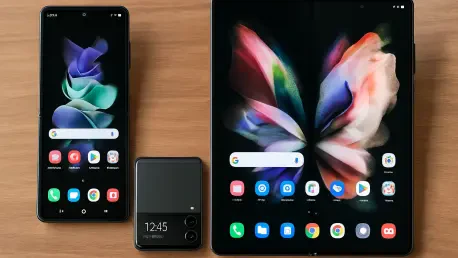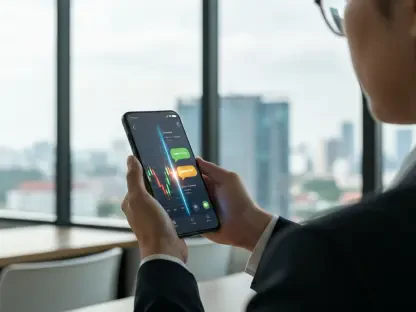Samsung continues to redefine smartphone innovation with its latest lineup of foldable devices, and for those intrigued by the clamshell-style design, the Galaxy Z Flip7 and Galaxy Z Flip7 FE (Fan Edition) stand out as two compelling choices. These phones cater to distinct segments of the market, balancing cutting-edge technology with affordability. The Z Flip7 positions itself as the premium option, packed with the newest advancements in design and functionality, while the Z Flip7 FE offers a more budget-conscious alternative without sacrificing the core foldable experience. This deep dive into their features aims to illuminate the differences and similarities, guiding potential buyers toward the device that best aligns with their needs, whether they prioritize top-tier innovation or value for money.
The decision between these two foldables often hinges on personal priorities, as both carry Samsung’s hallmark quality but target different user experiences. From design aesthetics to performance capabilities, each model brings something unique to the table. By exploring critical aspects such as build quality, screen usability, battery endurance, and camera output, this analysis seeks to provide clarity. Whether drawn to the sleek sophistication of a flagship or the practical appeal of a cost-effective option, understanding how these devices stack up can simplify the choice in a rapidly evolving tech landscape.
Design and Build: Style Meets Durability
Refined Elegance vs. Compact Comfort
The Galaxy Z Flip7 and Z Flip7 FE both tip the scales at around 190 grams, ensuring they don’t feel much heavier than traditional smartphones when slipped into a pocket. However, their physical dimensions paint contrasting pictures. The Z Flip7 boasts a noticeably slimmer profile in both folded and unfolded states, lending it an air of sophistication and a premium tactile experience. This streamlined design appeals to those who value a modern, high-end aesthetic. In contrast, the Z Flip7 FE appears slightly thicker but benefits from a narrower width when unfolded, measuring 3.3mm slimmer than its counterpart. This makes the FE easier to grip and maneuver, especially for users with smaller hands or those who prefer one-handed operation. Choosing between the two often comes down to whether sleekness or ergonomic comfort takes precedence in daily use.
Beyond mere measurements, the design philosophies behind these devices reflect their intended audiences, showcasing unique approaches to style and usability. The Z Flip7’s refined contours suggest a focus on luxury and cutting-edge appeal, potentially drawing in tech enthusiasts who want their device to make a statement. Meanwhile, the Z Flip7 FE prioritizes practicality with its more compact unfolded width, which might resonate more with users seeking functionality over flair. Both phones manage to avoid feeling cumbersome despite their foldable nature, but the subtle differences in how they fit into a hand or pocket could sway preferences. Ultimately, the decision here hinges on whether the allure of a polished look outweighs the convenience of a snugger fit for everyday handling.
Durability and Material Standards
When it comes to build quality, both the Z Flip7 and Z Flip7 FE showcase Samsung’s commitment to durability with materials that stand up to the rigors of daily life. Each device features Gorilla Glass Victus 2 on the exterior for enhanced scratch resistance, paired with robust Armor Aluminum frames that promise resilience against accidental drops. They also share an IP48 rating, meaning protection against solid particles larger than 1mm and submersion in up to 1.5 meters of water for 30 minutes. This level of ruggedness ensures confidence in various environments, from dusty outdoor settings to unexpected spills. Additionally, both are rated for durability against 210 falls per EU standards, though real-world outcomes may differ based on usage conditions.
Further examination reveals that Samsung has equipped both models with hinges designed to withstand the repeated folding and unfolding inherent to their form factor, ensuring durability for users who frequently open and close their devices. While the Z Flip7’s hinge is marketed as more advanced, no significant functional disparity is evident compared to the FE’s mechanism. This parity in construction quality means that neither device feels like a compromise in terms of longevity or structural integrity. For consumers concerned about the wear and tear of a foldable phone, both options offer reassurance through premium materials and protective ratings. The focus on durability across these models underscores Samsung’s intent to make foldable technology reliable for a broad user base, regardless of price point.
Display: Screen Size and Usability
Expanded Visuals on the Premium Model
One of the most striking differences between the Galaxy Z Flip7 and Z Flip7 FE lies in their display configurations, significantly impacting user interaction. The Z Flip7 pushes boundaries with a spacious 4.1-inch edge-to-edge cover display, allowing for more intuitive use of apps, notifications, and even camera viewfinders without unfolding the device. Internally, it features a 6.9-inch foldable panel with a 22:9 aspect ratio, delivering an immersive experience for media consumption and multitasking. This expanded screen real estate caters to users who crave versatility and a larger canvas for both quick glances and deep engagement. The seamless integration of such generous displays elevates the foldable experience, making the Z Flip7 a standout for those who prioritize visual interaction.
In contrast, the Z Flip7 FE adheres to a more conventional approach with a 3.4-inch notched cover display and a 6.7-inch internal screen, also at a 22:9 aspect ratio. While still functional, the smaller cover screen can feel restrictive, particularly for tasks like framing photos or typing quick replies, often necessitating unfolding the phone more frequently. This limitation might frustrate users accustomed to maximizing external screen utility. Although the internal display remains adequate for most activities, it lacks the expansive feel of the Z Flip7’s panel. For potential buyers, the choice here revolves around how much value is placed on screen size for both external convenience and internal immersion, as the Z Flip7 clearly offers a more dynamic visual platform.
Performance Metrics: Brightness and Fluidity
Beyond sheer size, the display performance metrics of brightness and refresh rate further distinguish these two devices, affecting visibility and smoothness. On the internal screens, both the Z Flip7 and Z Flip7 FE achieve comparable brightness levels in manual and adaptive modes, ensuring readability in varied lighting conditions. However, the Z Flip7’s cover display shines brighter by approximately 200 nits, providing a clearer view under direct sunlight compared to the FE’s still-respectable 1150 nits. This difference, though not drastic, could be noticeable for users who frequently check their cover screen in bright outdoor environments, potentially tipping the scales toward the premium model for those in sunnier climates or with active lifestyles.
Refresh rates also play a significant role in the user experience, with both internal displays supporting up to 120Hz and adaptive refresh technology for smooth scrolling and animations. However, a difference arises with the cover screens—the Z Flip7 matches its internal 120Hz capability, ensuring fluid interactions even when closed, while the Z Flip7 FE is limited to 60Hz, resulting in less seamless external navigation. This discrepancy might not bother casual users but could be a drawback for those who value responsiveness across all aspects of their device. When weighing these factors, the Z Flip7 emerges as the better choice for display performance, catering to those who demand crisp visuals and smooth transitions, while the FE remains adequate for less demanding needs.
Battery and Charging: Power for Your Day
Staying Powered Longer with the Z Flip7
Battery capacity and endurance are pivotal for any smartphone, especially foldables where power demands can be higher due to dual displays, and the Galaxy Z Flip7 takes a clear lead in this arena. Equipped with a 4,300mAh battery, it outlasts the Z Flip7 FE’s 4,000mAh capacity, a difference that becomes evident in real-world usage. Thanks to a more efficient chipset and optimized power management, the Z Flip7 excels in key areas like video playback and web browsing, offering extended runtime for multimedia enthusiasts or professionals on the go. Call time also sees a slight improvement, though gaming endurance remains comparable between the two. For users with heavy usage patterns, this enhanced staying power makes the Z Flip7 a more dependable companion throughout a demanding day.
Delving deeper into battery performance, the Z Flip7’s advantage isn’t just about raw capacity but how it integrates with daily habits. The additional 300mAh, combined with software optimizations, translates to fewer charging interruptions, which is crucial for those who rely on their device for constant connectivity or entertainment. Meanwhile, the Z Flip7 FE, while not inadequate, may require more frequent top-ups under similar conditions, potentially inconveniencing users during long stretches away from a charger. This disparity highlights a key consideration for buyers—whether the need for longer unplugged time justifies the premium price of the Z Flip7, or if the FE’s battery life suffices for lighter, more intermittent use.
Charging Speeds: A Shared Shortcoming
When it comes to charging capabilities, both the Galaxy Z Flip7 and Z Flip7 FE reflect Samsung’s characteristically cautious approach, resulting in a shared limitation that might disappoint fast-charging enthusiasts. Wired charging on both devices slows considerably past the 90% mark, extending the time needed for a full charge compared to competitors in the market. This conservative strategy aims to preserve battery health over time but can frustrate users accustomed to rapid top-ups. Wireless charging is supported on both, capped at 15W with Samsung’s proprietary pads, though third-party chargers may drop to as low as 5W per WPC standards, further limiting convenience for those without dedicated accessories.
Despite the identical charging hardware, both models incorporate battery health features such as adaptive charging based on user patterns and customizable charging limits to prevent overcharging stress. These safeguards ensure long-term battery integrity, which is a plus for users planning to keep their device for several years. However, the lack of differentiation in charging performance means neither phone gains an edge in this aspect, leaving buyers to focus on other features for their decision. For those who prioritize quick charging, this shared drawback might prompt consideration of external solutions like high-capacity power banks. Ultimately, charging speed remains a neutral factor, with both devices offering similar experiences that lag behind industry trends in rapid power delivery.
Performance and Software: Speed and Longevity
Hardware Power: A Step Up for the Premium Option
Performance is a critical differentiator in smartphones, and the Galaxy Z Flip7 asserts dominance over the Z Flip7 FE with superior hardware under the hood. Powered by the cutting-edge Exynos 2500 chipset, built on a 3nm process with a robust CPU configuration and an Xclipse 950 GPU, the Z Flip7 delivers top-tier performance. Coupled with 12GB of RAM and storage options of 256GB or 512GB, it handles intensive tasks like gaming and multitasking with ease. Benchmark results consistently show the Z Flip7 outpacing its counterpart, making it the go-to choice for power users who demand peak performance for demanding applications or seamless operation across multiple apps.
In comparison, the Z Flip7 FE relies on the Exynos 2400 chipset, a 4nm processor previously seen in other Samsung models, paired with 8GB of RAM and storage configurations of 128GB or 256GB. While still capable, with a solid CPU setup and an Xclipse 940 GPU, it falls short of the Z Flip7’s raw power, particularly under sustained workloads. Notably, both devices experience thermal throttling during extended use, meaning peak performance isn’t maintained over long periods. For casual users engaging in everyday tasks like browsing or streaming, the FE performs admirably without noticeable lag. However, for those pushing their devices to the limit with resource-heavy activities, the Z Flip7’s hardware advantage becomes a compelling reason to invest in the premium model.
Software Experience and Update Commitment
On the software front, both the Galaxy Z Flip7 and Z Flip7 FE launch with Android 16 and One UI 8, ensuring a modern and cohesive user interface right out of the box. Samsung’s commitment to software longevity shines through with a promise of 7 years of major OS updates and security patches, providing peace of mind for long-term ownership. This parity in software support means that buyers of either device can expect a consistent and up-to-date experience for years to come, a significant factor in an era where software updates often outpace hardware lifespans. Day-to-day operation feels smooth on both, with intuitive navigation and access to the latest features.
A minor concern lingers regarding the potential for delayed major updates on the Z Flip7 FE compared to the flagship Z Flip7, though this remains speculative and unconfirmed. Such a discrepancy, if it exists, might affect users who prioritize staying on the cutting edge of software advancements. Nevertheless, for most, the shared software foundation and extensive update policy ensure that neither device feels outdated prematurely. The focus on long-term support reflects Samsung’s dedication to customer satisfaction across its product tiers, making both foldables reliable choices for those who value a future-proof software ecosystem. When deciding, software isn’t likely to be a deciding factor, as both offer a robust and comparable experience tailored to diverse user needs.
CamerEqual Ground for Photography
Shared Hardware with Subtle Output Differences
Surprisingly, Samsung has chosen not to differentiate the camera systems between the Galaxy Z Flip7 and Z Flip7 FE, equipping both with the same hardware as their predecessor model—a 50MP main camera, a 12MP ultrawide without autofocus, and a 10MP internal selfie camera with fixed focus. In most shooting conditions, from well-lit environments to moderate indoor settings, photo quality remains nearly identical across the two devices. Images exhibit good detail, vibrant yet natural colors, and a wide dynamic range, meeting the expectations of casual photographers. However, a subtle edge emerges in ultrawide shots, where the Z Flip7 produces marginally sharper results, though the reason for this variance isn’t entirely clear and may be situational.
Video recording capabilities are theoretically on par due to identical hardware, yet minor differences appear in practice. The Z Flip7’s ultrawide videos tend to be crisper, while the Z Flip7 FE occasionally shows a slight advantage at 1x zoom in daylight. Low-light video performance is more balanced, with neither device consistently outperforming the other. For users prioritizing camera output as a key purchase factor, these minute discrepancies are unlikely to tip the scales significantly. Both phones cater adequately to social media enthusiasts and everyday memory-capturers, ensuring that photography doesn’t heavily influence the decision between the premium and budget-friendly options.
Performance Across Lighting and Scenarios
Delving into specific shooting scenarios, both the Galaxy Z Flip7 and Z Flip7 FE handle daylight photography with aplomb, delivering consistent results that impress with clarity and color fidelity. At 2x zoom, neither device shows a distinct advantage, maintaining comparable quality for cropped-in shots. Selfie performance from the internal camera is reliable on both, with minor shot-to-shot variations that don’t follow a clear pattern favoring one model. This uniformity ensures that users won’t feel shortchanged by opting for the less expensive model when it comes to capturing personal moments or group shots during bright conditions.
In low-light environments, the story remains largely the same, with both devices producing grainier images in standard Photo mode but cleaner results when switched to Night mode. Dynamic range and color reproduction hold steady across ultrawide and zoomed shots in dim settings, though the Z Flip7 FE’s ultrawide images can appear softer without Night mode assistance. These differences are subtle and often negligible for the average user, reinforcing that camera performance is a level playing field between the two. For those whose primary concern is photographic capability, either foldable offers a solid toolkit, leaving other factors like design or battery life to drive the final choice. Samsung’s decision to maintain camera parity ensures accessibility to quality imaging regardless of budget.
Final Thoughts: Making the Right Choice
Reflecting on the detailed comparison, it’s evident that Samsung crafted the Galaxy Z Flip7 and Z Flip7 FE with distinct user profiles in mind, successfully balancing innovation with accessibility. The Z Flip7 stood out as the flagship contender, impressing with a slimmer design, larger and more versatile displays, and superior battery endurance. Meanwhile, the Z Flip7 FE held its ground as a value-driven alternative, delivering a near-identical camera experience and a compact form factor at a more approachable starting price of $699.99 compared to the Z Flip7’s $1,099.99. Both devices shared shortcomings like slow charging speeds, but their strengths catered to varied needs within the foldable market.
Looking ahead, potential buyers should weigh their priorities against these insights to determine the best fit. For those captivated by cutting-edge features and willing to invest in premium design, exploring the Z Flip7’s offerings at a local retailer could solidify the decision. Conversely, budget-conscious individuals or newcomers to foldables might find the Z Flip7 FE’s blend of affordability and functionality ideal, warranting a hands-on test to confirm comfort and usability. Considering lifestyle factors—such as daily screen time or reliance on battery life—can further refine the choice. Samsung’s dual-tier approach ensures options for all, and taking the next step to experience these devices firsthand can turn this analysis into a confident purchase tailored to individual preferences.









